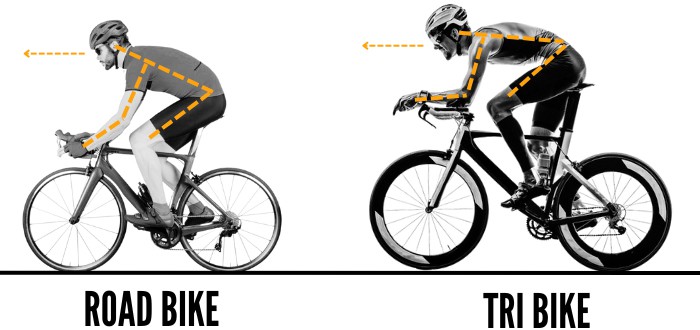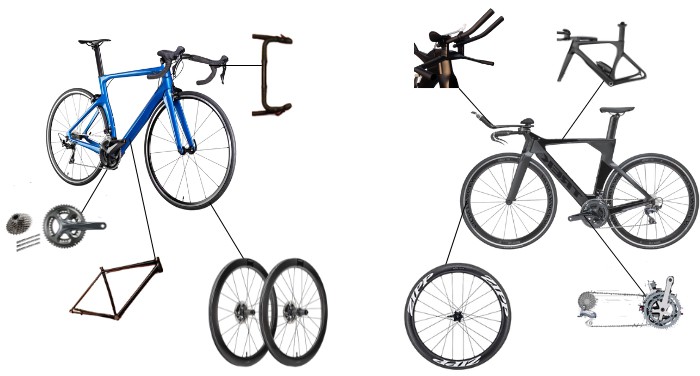Many bicycles look similar but function well in different ways. Such is the case when comparing a road bike vs tri bike. But what can each bring to the table, and how can we use them best?
Both road and tri bikes help riders move faster, but the latter is more aerodynamic due to its steeper tube angles and is generally more suitable for triathlons. Meanwhile, road bicycles are more versatile and better for climbing hills, turning, and accelerating.
There’s more to these two options, however, so read on.
Table of Contents
Comparison Points for Road and Triathlon Bikes
Road bikes are for speed, while MTBs are for cycling on trails—this is something many people know. However, other bicycles, such as the tri bike, also allow cyclists to ride fast, so let’s compare them.
- The road bicycle is traditional in its design, but its components have undergone decades of fine-tuning. This cycle is made with lightweight materials and designed to allow its rider to distribute their weight accordingly to travel faster.
- The triathlon bike can ride fast, but the way they achieve this speed is a bit different. Their frame possesses sharper angles and specialized geometry, such as lower handlebars and a more forward saddle than a road bike.
All of these are to improve the bicycle’s aerodynamics by reducing drag and significantly increasing riding speeds.
Triathlon cycles are faster but generally less versatile. This is especially evident during climbs and corners. Let’s look at the defining characteristics of each racing bike more closely.
Differences Between Road and Triathlon Bikes
| Road Bike | Triathlon Bike | |
| Handlebars | Drop bars allow riders to shift their weight, depending on the situation.
Suitable for everyday riding. |
Use aero bars with handles that protrude forward, enabling cyclists to assume an aerodynamic riding position.
Not for everyday riding. |
| Frame | Lightweight materials with a less aggressive frame shape Frames have longer head tubes. | Sharper angles are used along with more dynamic and, at times, extreme shapes, all for better aerodynamics. The head tubes are shorter. |
| Gears | A wide range of gears is used for better flexibility in different situations. Has two front chainrings | Narrower gear range with one front chainring |
| Brakes and wheels | Have standard rim and disc brakes. The same goes for the wheels. | Disc brakes are the same, but rim brakes are built into the frame, resulting in less control.
Wheels are often deep-sectioned or rear disc types, which hardly appear on road bikes. |
| Riding experience | More comfortable to ride due to being able to sit with the back upright. | Assuming an aerodynamic cycling position can strain the body more than riding on road bikes. |
A few of the most significant differences between these cycles are discernable by looking at the frames, handlebars, and overall comfort; however, many points are similar if not the same.
To illustrate this similarity, it is possible to use a road bike for triathlon events competitively, simply by switching to aero bars to access the specialized riding posture and adjusting the seat forward.
On the other hand, the biggest problem you will have if you use a tri bike for road cycling events is that some triathlon frame designs may be too extreme to qualify under international competitive cycling rules.
If your frame is more traditional, it is possible, although this involves more effort to convert the design.
Tri Bike vs Road Bike: Pros and Cons
Each of these bicycles have its own strengths and weaknesses. Becoming familiar with them can help us decide how to best make use of each. First, let’s take a look at roadies.
1. Road Bike
- Both fast and versatile
- Allows multiple riding positions
- Comfortable to ride, even over long distances
- Not as fast as a tri bike on flats
Triathlon cycles are designed for very specific types of cycling events and situations. Below we have a list of their notable advantages and disadvantages.
2. Tri Bike
- Can reach higher speeds compared to road bike
- Steeper seats are less taxing on the hamstrings and calves.
- Not for group rides like road bikes
- Less comfortable riding position where bumps are more evident
- Sensitive to wind and weather conditions
Which is the Better Bike?
As it always seems to go with these comparisons, the best one depends on what kind of cycling you are going for.
- Tri bikes have superior speed, but it is worth mentioning that it becomes more difficult to maintain this superiority on more technical courses where there are a high number of climbs and corners.
It’s not that tri bikes lose out to roadies on such courses—it just takes more effort and skill to keep performing at a high level.
- Another key difference is that roadies are common in events where drafting comes into play. This is when cyclists ride behind another bicycle to reduce drag and perform with less effort.
Triathlon bikes are mostly necessary in events where drafting is not an option; such events include time trial competitions and most triathlon formats.
- Price is another important factor, since there is a significant difference between road and tri bike costs. For entry-level models, you can find good deals for roadies at below $1000, but triathlon cycles have an average price of $4000.
Conclusion
Now, we understand enough to compare a road bike vs tri bike. While it may be confusing to have multiple cycles that focus on speed, it is also to our benefit to have different options to choose from. Ultimately, it may be best to test-ride both and see what works for you.
Have you seen or ridden a triathlon bike before? What is your impression of it, and is it better than the old reliable road bicycle? Tell us what you think in the comments section below.
Always ride safely.

“I ride my bike to work for years, but is that enough? Our carelessness towards our surroundings has taken a toll on the environment. And now, everyone is responsible for changes; even the most minor contribution is counted. With this hope and spirit, I started with my partner to establish Biketoworkday to help more individuals commute to their work sites on their bikes.”






